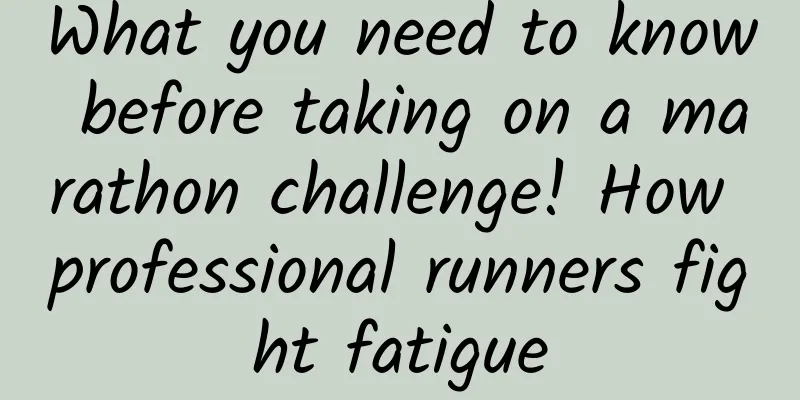What you need to know before taking on a marathon challenge! How professional runners fight fatigue

|
In recent years, many large-scale marathons and road running events have been held in Taiwan. The Taipei Marathon, Taroko Run, ColorRun, Luminous Run, etc., combine popular running themes such as travel, tourism, and fashion, allowing "road running" to transcend the scope of competition and become an important topic of life and leisure for everyone to participate. But whether it is a 10-kilometer, half-marathon or even a full marathon of 42 kilometers, road running is often more than 10 kilometers long, constantly challenging the limits of personal physical strength and willpower. How to "fight fatigue" and challenge one's own limits has become a topic of concern for every runner. On August 12, 2012, 29-year-old Mo from London. Farah took to the track for arguably the biggest race of her life: the 5,000-meter final at the London Olympics. As he approached the starting line, a group of people from his hometown stood up happily to welcome him. A week earlier, they had watched him win the 10,000-meter gold medal and go down in history. It was Britain's first gold medal win in a tournament dominated by Ethiopia and Kenya. Now, they expect him to win again. Although he is a strong contestant, the situation this time is completely different from the last time. Farah is still recovering from last week's race, and the 5,000-meter track and field event is even more challenging. At that time, his speed was only ranked 11th in the world, while the top 7 track and field athletes in the world were standing next to him, including the world's fastest Dejan. Gebremeskel. He is a legend in Ethiopia and everyone thinks he is the favorite to win the championship. Fortunately for Farah, the 12-and-a-half-lap race was decided at the end. He ran with ease most of the time throughout the game. With the last kilometer left, he was in second place, just behind Gebremesker. At this time, he began to quicken his pace. In the stands, among the thousands of spectators waving British flags, in addition to Farah's stepdaughter, there was also his wife Tanya, who was pregnant with twins. Farah took the lead. The bell for the last lap rang, and he took big strides to distance himself from the others. His slender figure in a white vest and blue shorts moved forward smoothly, a golden necklace swinging around his neck. Then, around the last turn, Gebremeskel, wearing a green vest with a yellow collar, approached quickly. It looked as if the popular favorite was going to win, but the noise from the crowd seemed to encourage Farah. He bared his teeth, waved his arms, and distanced himself from Gebremesker, then quickly crossed the finish line with his eyes wide open, excited and full of disbelief. It took Farah 4 minutes to complete the last kilometer, and only 52.94 seconds to complete the last lap. BBC commentator Steve, who was once a long-distance runner. Crane was very emotional. "Words can't express how I feel," he enthused. "Have you ever witnessed anything like this?" Farah said as he presented the two gold medals to his unborn twin daughters. I was watching the game at home with a big belly. From my family to the whole country, everyone was excited because of Farah's victory. Britain had never won an Olympic gold medal in long-distance athletics, but now we had two of them and Farah became a national hero. “The audience was encouraging me,” he said afterwards. “If it weren’t for them, I don’t think I would have been able to run so fast.” Without a doubt, Farah used every ounce of energy, every inch of muscle, and every bit of willpower to help us win that gold medal. And for me, just as amazing as Farah's exhilarating final sprint was what he did after he crossed the finish line. He did not collapse to the ground due to exhaustion. Instead, he started doing sit-ups with full energy for the audience. Then, he jumped up again and slowly ran along the runway towards the photographers waiting on the side, bending his hands above his head and making his signature M pose. We often see the same phenomenon in sports competitions. The world record was broken, and the final sprint won the victory. The athletes clearly put every ounce of energy into getting their bodies into peak condition. Once they cross the finish line, they still have the energy and vigor to run around the field. This phenomenon makes people wonder, similar problems also occur among mountaineers who climb Mount Everest. Why do we retain so much energy when we feel we have reached our breaking point? Tim. Knox, an exercise physiologist at the University of Cape Town in South Africa, is the type who doesn't fear authority. In fact, he often overturned dogma, a move that sometimes earned him enemies but sometimes saved athletes’ lives. In the 1980s, for example, he conducted some research that found that South African rugby players were prone to serious neck injuries. His findings were strongly rejected by the scientific community at the time, but ultimately led to a change in the rules of the game. He then began to study why many marathon runners fainted. The conclusion was that the reason was not dehydration as everyone thought, but the opposite: they drank too much water. Knox believes that professionals are poisoning runners by advising them to drink about 1.5 liters of water within an hour. Influenced by the sports drink industry, American experts denied his findings. This statement was never revised until the 2002 Boston Marathon, when 13% of participants suffered water intoxication—one of whom died. "My experience of coming into conflict with the US sports drink industry, which makes billions of dollars a year, taught me a lesson. Medicine can easily be used to 'achieve the greatest benefit for all mankind', but it can also easily be turned for commercial interests," said Knox. Not surprisingly, then, Knox had spent several years attacking one of the most fundamental assumptions of physiology. Since I am an athlete myself, I am very interested in the topic of fatigue. “When you exercise, you often feel tired and wonder why,” he told me. “I soon discovered that the reasons were different from what I had been taught in school.” Traditionally, athletes feel tired because their bodies have reached the limits of their capabilities—muscles are starved of oxygen and energy, or are damaged by the buildup of toxic byproducts such as lactic acid, causing pain and fatigue that forces them to stop exercising until their bodies can repair themselves. Since the Nobel Prize-winning physiologist Archibald. Since Hill proposed this basic theory in 1923, no one has questioned it to this day. However, when Knox tested this theory, he found that the results did not make sense. First, Hill's theory predicts that if athletes are pushed to the limit of their physical fitness, then their oxygen consumption should remain stable until they stop from exhaustion, because the heart can no longer beat faster to deliver the oxygen needed by various tissues. But as the high-altitude tests showed, this did not happen. “During testing, we had no cases of athletes running out of oxygen,” he said. "No such thing happened." On the other hand, other studies have shown that although the energy inside the muscles (glycogen, fat, and ATP) is consumed during exercise, it is never completely depleted. Knox also studied muscle use by asking cyclists to ride on a flywheel while measuring wires were connected to their legs. Hill's theory states that when an athlete is tired, they begin to pool all available energy sources in the body, and more and more muscle fibers join the battle until the body can no longer bear the load and reaches the limit of physical strength. But Knox found just the opposite. When a cyclist runs out of steam, his muscle fibers stop working. At no point did the volunteers report they were too tired to continue, with the number of muscle fibers activated exceeding 50 percent. Exhaustion caused them to stop exercising, but they still had a lot of muscle left in their bodies waiting to be used. These experimental results convinced Knox that his previous belief—that fatigue came from muscles reaching their limit—could not be correct. So he and his colleague Alan. St. Clair Gibson proposed that the feeling of tiredness is imposed by centers in the brain. Obviously the body has its physical limits, and Knox and St. Clair Gibson argue that these limits are not reflected directly in muscle soreness, but rather through the brain acting one step ahead, making us feel tired and forcing us to stop exercising before any nerve endings show signs of damage. In other words, fatigue is not a physical condition but a feeling or emotion created by the brain to prevent serious harm. They call the brain system that does this "control centers." From an evolutionary point of view, it is quite plausible that similar systems exist. Signs of muscle damage alone warn us of our physical strength Pushing our limits puts us too close to the edge of passing out every time we run out of energy. Stopping physical activity early provides a safe margin of error and means there is a way to continue moving even after you have just completed an exhausting challenge. “We believe this is how humans evolved, because you always have to finish what you’re doing and still need some energy to do other things,” Knox said. For example, we might suddenly need to flee from an animal that would prey on us. “When we’re hunting, we always need a little extra energy to bring the food home.” That’s why, even after Farah ran until her heart was about to burst, she still had energy left over for sit-ups and a jog after finally crossing the finish line and winning her second gold medal. When Knox first proposed the control center theory more than a decade ago, everyone thought it was ridiculous that the brain, rather than the heart, lungs or muscles, might be the key to physical performance. To this day, his ideas remain controversial. For example, Martin, who has done research on Everest, said that while Knox is "very likely right" that it's not the lack of oxygen but the control center that makes us tired quickly at altitude, there's "no evidence to support" that hypothesis. While exercise physiologists remain on the sidelines, psychologists are increasingly convinced that the brain does play an important role in the body's fatigue response. For example, many performance-enhancing drugs (such as amphetamines, tamoxifen, and caffeine) work by affecting the central nervous system rather than the muscles themselves. Scientists have also tried to directly stimulate cyclists' brains with electrical currents to promote maximum power output and make them less likely to feel tired. Knox said he hopes that brain imaging studies in the next few years will help directly prove the existence of the control center. However, what I am most interested in about the idea that fatigue responses are controlled by the brain is whether consciousness plays any role in it. Is there a way for us to actually manipulate the control center? There is growing evidence that it sometimes can. A large number of studies have shown that psychological factors can affect our perception of fatigue and adjust the time when we feel tired. For example, an athlete's performance is influenced by motivation (the presence of prize money or competitors, or the sound of a gun), the ratio of being in a win or loss situation, and how far we think we have to go. On the other hand, Chris, a psychologist at Aberystwyth University in Wales. Bidi discovered that as long as the bicycle is allowed to choose The average speed of the hands was 2% to 3% faster when they believed that the pill or drink they had just swallowed could increase their physical strength. In many races, it’s easy to see a change in pace between the rider on the verge of winning the gold medal and the rider on the verge of falling behind. Biddy believes that the changes occur because the placebo makes them more optimistic and confident, triggering the control center to release more energy. “The brain is capable of amazing things, but it also limits you,” he said. Taking a placebo can release these self-restraints. (Placebo expert Fabrizio Benedetti also likes Knox's idea, and wrote in a paper on fatigue that "placebos may function as a signal to the control center to stop limiting.") It turns out that in addition to physical variables such as temperature, oxygen supply, physical fitness and exercise intensity, the brain also considers psychological variables such as confidence levels or the importance of things. The brain then uses fatigue to frame the maximum speed. If we have doubts about our fitness or are unsure of how far we have to run, we will go slower. But if we are clear about the goal at hand, or the situation is a matter of life and death, the control center will be untied after considering this. This is why, in critical situations, people are able to demonstrate extraordinary strength and endurance, and accomplish things that would be impossible under normal circumstances. And if the situation changes, our fatigue level will also adjust accordingly. When we’re running a race, we suddenly feel energized the moment we see the finish line; if we’re facing a threat, we feel exhausted once the crisis is over. When Farah competes in the 5,000 meters, motivation, confidence, and the support of the crowd all add up to trigger control centers that allow him to perform at his best, enabling him to outperform his competitors. On the other hand, Messner and Haberner's fierce determination to succeed seemed to push their physical abilities to dangerous limits, enabling them to climb to record-breaking altitudes that nearly cost them their lives. The existence of this control center may explain why interval training—short bursts of intense exercise followed by regular breaks for rest—can be so effective. Knox says regular sprints that push your body to its limits not only improve your fitness, but also retrain your brain. These sprinting behaviors will teach the control center that we can do these difficult movements, so even if the difficulty is higher next time, there will be no danger. But perhaps it’s reassuring to know how overly protective the brain is of this body. “You don’t have to trust your feelings or everything your brain says,” Knox said. “No matter how painful it is, you can keep going and do better.” This article is from "Healing Power" published by Aimili |
>>: Homemade refreshing cold noodles in summer! Tips for choosing safe ingredients
Recommend
How to treat abnormal leucorrhea with foul odor
Abnormal leucorrhea with a foul odor may be a sig...
The treatment of ovarian cysts should be based on the actual situation of the patient
For women who want to give birth, ovarian cysts c...
What are the symptoms of cervicitis
Cervicitis refers to inflammation of the cervix, ...
Is grade 1 cervical precancerous lesion serious?
Life is like a big stage, and people are performi...
Cost of diagnosis of endometrial tuberculosis
Nowadays, many female friends are troubled by end...
The causes of vaginal diseases are mainly divided into three aspects
Due to the structural characteristics of the fema...
How long does it take to have a normal menstrual period after hysteroscopic surgery for endometrial polyps?
After hysteroscopic surgery for endometrial polyp...
Treatment of Hyperprolactinemia with Chinese and Western Medicine
In today's fast-paced work and life, many wom...
Is benign ovarian cyst serious? How to treat it effectively?
Is benign ovarian cyst serious? What is the best ...
What are the main causes of vulvar leukoplakia?
What are the main causes of vulvar leukoplakia? P...
TCM Syndrome Differentiation and Classification of Irregular Menstruation
Traditional Chinese medicine believes that menstr...
How to best prevent adnexitis
What is the best way to prevent adnexitis? What w...
What are the harms of abortion to the human body? Women must know the harms of abortion
With the progress of society and the opening of p...
Introduction to several main symptoms of chronic cervicitis
Clinically, the onset of chronic cervicitis is ve...
Will frequent sexual activity lead to cervicitis? What are the common methods to fight cervicitis?
Cervicitis is a common disease in women of childb...









